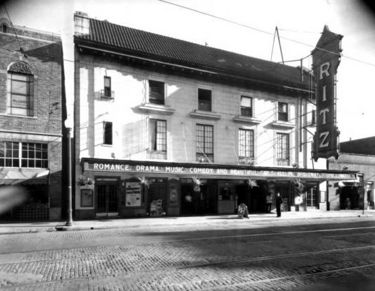Ritz Theatre: Difference between revisions
No edit summary |
No edit summary |
||
| Line 1: | Line 1: | ||
[[Image:Ritz Theatre.jpg|right|thumb|375px|The Ritz Theatre in 1933. {{BPL permission caption|http://bplonline.cdmhost.com/u?/p4017coll6,1337}}]] | [[Image:Ritz Theatre.jpg|right|thumb|375px|The Ritz Theatre in 1933. {{BPL permission caption|http://bplonline.cdmhost.com/u?/p4017coll6,1337}}]] | ||
[[Image:Cinerama Ritz sign.jpg|right|thumb|150px|Post-1962 Cinerama sign]] | |||
The '''Ritz Theatre''' was a "million dollar" air-conditioned movie theater built on the 1700 block of [[2nd Avenue North]] for the Interstate Amusement Company. Seating 2,000, the Ritz was the largest in the city when it was completed, and second only in size to the [[Alabama Theatre]], built the following year. | The '''Ritz Theatre''' was a "million dollar" air-conditioned movie theater built on the 1700 block of [[2nd Avenue North]] for the Interstate Amusement Company. Seating 2,000, the Ritz was the largest in the city when it was completed, and second only in size to the [[Alabama Theatre]], built the following year. | ||
It opened on [[August 15]], [[1926]] with a screening of "More Pay-Less Work" starring Mary Brian and Buddy Rogers. Before the film was a stage performance by vaudeville stars Herman and Sammy Timberg. The first manager was [[Vernon Reaver]]. | It opened on [[August 15]], [[1926]] with a screening of "More Pay-Less Work" starring Mary Brian and Buddy Rogers. Before the film was a stage performance by vaudeville stars Herman and Sammy Timberg. The first manager was [[Vernon Reaver]]. | ||
In [[1930]] the theater was bought by the Radio-Keith-Orpheum Company (RKO) and [[Karl Hoblitzelle]] was named managing director. In [[1933]] the operation was sold again, to the | In [[1930]] the theater was bought by the Radio-Keith-Orpheum Company (RKO) and [[Karl Hoblitzelle]] was named managing director. In [[1933]] the operation was sold again, to the Wilby-Kincey Corporation. By the end of that decade the theater's 2/6 Kilgen/Robert Morton pipe organ was no longer in use. | ||
In [[1962]] the | In [[1962]] Wilby-Kincey updated the property for wrap-around Cinerama projection. The project involved demolition of the lobby and a reduction in seating capacity from 1,700 to 500. An enormous stage curtain was installed to mask the damage. The remodeled theater, managed by [[Cecil Brown]], re-opened in June as the '''Cinerama Ritz'''. The opening night screening of 1952's ''This is Cinerama'' was accompanied by the [[Birmingham-Southern College Choir]], a Marine Corps color guard, [[Miss Alabama]] [[Delores Hodgens|Delores Hodgens Howard]] and [[Governor of Alabama|Governor]] [[John Patterson]]. | ||
[[Image:Ritz demolition 1982.jpg|left|thumb|375px|Demolition of the Ritz in 1982. Photo by John McDavid]] | [[Image:Ritz demolition 1982.jpg|left|thumb|375px|Demolition of the Ritz in 1982. Photo by John McDavid]] | ||
| Line 15: | Line 16: | ||
==References== | ==References== | ||
* "[http://bplonline.cdmhost.com/u?/p4017coll6,1081 Ritz Theater is bought by R-K-O]" (May 16, 1930) ''Birmingham News'' - accessed via Birmingham Public Library Digital Collections | * "[http://bplonline.cdmhost.com/u?/p4017coll6,1081 Ritz Theater is bought by R-K-O]" (May 16, 1930) ''Birmingham News'' - accessed via Birmingham Public Library Digital Collections | ||
* | * Caldwell, Lila May (June 24, 1962) "[http://www.birminghamrewound.com/features/CineramaRitz-2%20(6-62).jpg Cinerama comes to Alabama: 'This is Cinerama' is first of many spectacular films]" {{BN}} - via [[Birmingham Rewound]] | ||
* {{Hollis-2005}} | |||
[[Category:Former cinemas]] | [[Category:Former cinemas]] | ||
Revision as of 12:06, 2 June 2012

The Ritz Theatre was a "million dollar" air-conditioned movie theater built on the 1700 block of 2nd Avenue North for the Interstate Amusement Company. Seating 2,000, the Ritz was the largest in the city when it was completed, and second only in size to the Alabama Theatre, built the following year.
It opened on August 15, 1926 with a screening of "More Pay-Less Work" starring Mary Brian and Buddy Rogers. Before the film was a stage performance by vaudeville stars Herman and Sammy Timberg. The first manager was Vernon Reaver.
In 1930 the theater was bought by the Radio-Keith-Orpheum Company (RKO) and Karl Hoblitzelle was named managing director. In 1933 the operation was sold again, to the Wilby-Kincey Corporation. By the end of that decade the theater's 2/6 Kilgen/Robert Morton pipe organ was no longer in use.
In 1962 Wilby-Kincey updated the property for wrap-around Cinerama projection. The project involved demolition of the lobby and a reduction in seating capacity from 1,700 to 500. An enormous stage curtain was installed to mask the damage. The remodeled theater, managed by Cecil Brown, re-opened in June as the Cinerama Ritz. The opening night screening of 1952's This is Cinerama was accompanied by the Birmingham-Southern College Choir, a Marine Corps color guard, Miss Alabama Delores Hodgens Howard and Governor John Patterson.
In the 1970s the theatre screened "grindhouse" films. Its last screening was of "Thunder and Lightening" starring David Carradine and Kate Jackson.
The vacant theater was put up for auction in 1982. Robbie Arbitelle, owner of the neighboring Magic Palace magic shop, took possession of some seats and other artifacts, which he displayed in his store. He made a bid for the theater building, but lost out to the T. M. Burgin Demolition Company, which tore down the Ritz that year.
References
- "Ritz Theater is bought by R-K-O" (May 16, 1930) Birmingham News - accessed via Birmingham Public Library Digital Collections
- Caldwell, Lila May (June 24, 1962) "Cinerama comes to Alabama: 'This is Cinerama' is first of many spectacular films" The Birmingham News - via Birmingham Rewound
- Hollis, Tim (2005) Birmingham's Theater and Retail District. Images of America series. Charleston, SC: Arcadia Publishing. ISBN 0738517771

